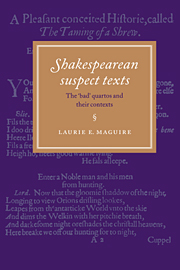8 - ‘Tables … stored full’
Published online by Cambridge University Press: 19 October 2009
Summary
We must… be confident that we can clearly distinguish between memorial contamination and other forms of corruption, and of this it maybe easier to convince ourselves than others.
W.W.GregAny survey of forty-one suspect texts inevitably assembles a large amount of textual data. My aim has been to make this material available in as judicious, unbiased, and neutral a manner as possible. As a discussion of each play in narrative format is precluded both by limitations of space and by my desire to focus on textual methodology rather than on conclusion, I have chosen to present the data from the forty-one suspect texts in tabular form.
Tabular format minimises the ‘cause and effect’ scenario inherent in the narrative method, and also provides an accessible summary of textual quiddities. The layout of the tables and their consecutive presentation permit a detailed picture of features within an individual play, a comparative overview of all features of all forty-one playtexts, and of any single feature (e.g. internal repetitions) across the forty-one texts. The tables record textual features; they do not generally explain them. In identifying and interpreting the features I have applied the diagnostic principles of chapter 7.
Table 1 does not itself refer to any playtext: it summarises the criteria by which the information in tables ii–xli has been assembled.
Tables ii–xlii contain textual information on each of the forty-one suspect texts, arranged in twenty categories as follows. The first four categories comprise factual, historical information: A) Play/Text Used; B) Stationers' Register/Quarto Dates; C) Printer/Publisher; D) Author/Company.
- Type
- Chapter
- Information
- Shakespearean Suspect TextsThe 'Bad' Quartos and their Contexts, pp. 227 - 322Publisher: Cambridge University PressPrint publication year: 1996
- 1
- Cited by



